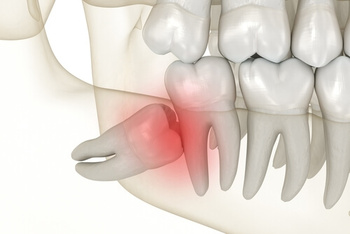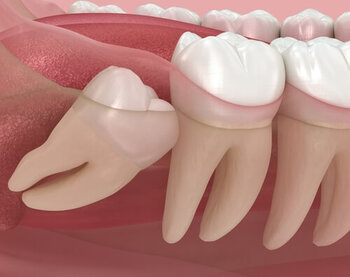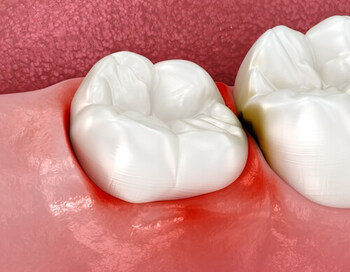
- Harris Dental Boutique
- wisdom teeth extraction, wisdom tooth impaction
- Dental Health
Wisdom tooth pain can be hard to ignore. It might start as a dull ache or suddenly become sharper when you least expect it. Sometimes, it makes chewing or even opening your mouth uncomfortable. Why does this pain happen, and what can you do about it? Knowing more about wisdom tooth pain can help you understand what’s happening and take steps to feel better. Let’s explore the reasons behind this discomfort and how to handle it.
What Causes Discomfort After Wisdom Teeth Eruption?
Wisdom teeth can bring noticeable discomfort as they erupt, especially if they don’t align well with other teeth. Understanding why this pain occurs can help you address it effectively and know when to seek help. Let’s explore the reasons behind the discomfort linked to wisdom teeth eruption.

Pressure as Wisdom Teeth Push Through
When wisdom teeth develop, they may push against the surrounding teeth due to limited space in the jaw. This pressure can cause tooth pain and make the gums around the area feel sore or swollen. As the wisdom tooth pushes through the gums, it may not have enough room to grow correctly, leading to ongoing irritation.
Impacted Wisdom Teeth and Jaw Pain
When there’s not enough space for your wisdom teeth, they can become trapped, either beneath the gum or against other teeth. Impacted wisdom teeth often lead to jaw pain, swelling, and tenderness. The pressure from an impacted tooth can also affect the alignment of nearby adult teeth, creating additional discomfort.
Gum Irritation and Inflammation
When wisdom teeth partially erupt, they leave openings in the gums where bacteria and food can get trapped. These openings make it easy for infections to develop, causing gum disease and increased dental pain. The area around partially erupted wisdom teeth often becomes red, swollen, and painful to touch.
Tooth Decay and Wisdom Tooth Pain
A wisdom tooth located far back in the mouth can be harder to clean properly. This can lead to tooth decay, which contributes to wisdom tooth pain. Cavities in these hard-to-reach areas may also spread to surrounding teeth, increasing the discomfort.
Pressure on Other Teeth
When all four wisdom teeth come in, they may crowd the other teeth in your mouth. This pressure can cause shifting, making your bite feel uncomfortable. If the alignment of other teeth is affected, it may lead to additional tooth pain or difficulty chewing.
Infections and Severe Pain
If a painful wisdom tooth is left untreated, infections can develop in the surrounding tissues. These infections can result in severe pain that extends to other areas of the mouth or even the jaw. Swelling, difficulty opening your mouth, or bad breath are common signs of infection caused by wisdom teeth.
When Wisdom Teeth Cause Nerve Pain
In some cases, wisdom teeth that grow too close to nerves in the jaw may lead to ongoing pain or numbness. This is more likely to happen if the wisdom teeth are positioned awkwardly or grow at an angle.
Bone or Tissue Pressure
As wisdom teeth push against other teeth or jawbone structures, the added pressure can create persistent soreness. This is especially true when wisdom teeth try to emerge in an area that lacks adequate space.
Discomfort from wisdom teeth can range from mild irritation to severe pain, depending on how they erupt and their position. If you notice ongoing dental pain or difficulty with chewing, it’s important to have your wisdom teeth checked by a dentist to ensure they don’t cause further issues. Addressing these concerns early can help minimise long-term problems.
What Is the Process of Extracting Wisdom Teeth?
Wisdom teeth removal is a carefully planned procedure designed to address discomfort and maintain oral health. The process involves several steps to ensure it is performed smoothly and effectively. Here’s an overview of how wisdom teeth are extracted.
Step 1: Consultation and Planning
A consultation is needed before the procedure to check how your wisdom teeth are positioned and their condition. The dentist will review X-rays to see if the teeth are causing issues or are impacted. This step helps plan a solution to reduce discomfort or avoid future complications.
Step 2: Preparing for the Procedure
On the day of the procedure, the dentist ensures you’re comfortable before starting. A local anaesthetic is usually applied to numb the area around the wisdom teeth. If multiple wisdom teeth are being removed or if the case is complex, sedation may be recommended to keep you relaxed during the procedure.
Step 3: Accessing the Tooth
Once the area is numbed, the dentist carefully accesses the wisdom tooth. For teeth that have fully erupted, a simple removal process can be performed. For impacted teeth or those trapped beneath the gums, a small incision may be made to reach the tooth. In some cases, a tiny portion of bone covering the tooth may need to be removed to expose it fully.

Step 4: Extracting the Wisdom Teeth
With the tooth exposed, the dentist gently loosens it from its socket using specialised tools. If the tooth is large or positioned awkwardly, it may be divided into smaller pieces for easier removal. This step is done carefully to minimise any disruption to the surrounding tissue.
Step 5: Managing the Socket
Once the wisdom teeth are removed, the empty sockets are cleaned to ensure no debris remains. This helps reduce the chance of infection and supports proper healing. In some cases, stitches may be used to close the area, especially if an incision was made during the procedure.
Step 6: Ensuring Comfort
After the extraction, the dentist ensures the area is secure and provides initial pain relief to help you feel comfortable as the anaesthetic wears off.
Step 7: Post-Procedure Review
Once the procedure is complete, the dentist will review aftercare instructions with you. These steps are important to promote healing and reduce discomfort following wisdom teeth removal.
The process of extracting wisdom teeth is tailored to meet each individual’s needs, whether it’s to relieve pain or address impacted teeth. By following a step-by-step approach, the procedure is performed with care and precision, ensuring the best possible outcome for your oral health.
What Are the Best Practices for Caring for Your Mouth After Wisdom Teeth Removal?
Taking proper care of your mouth after having your wisdom teeth removed is key to ensuring a smooth recovery. Following best practices helps promote healing, reduces discomfort, and prevents complications. Let’s explore how you can care for your mouth effectively after this procedure.
Keep the Area Clean
Maintaining cleanliness in your mouth is essential after wisdom teeth removal. For the first day, avoid brushing near the extraction site to allow the area to stabilise. From the second day onwards, gently clean the surrounding teeth with a soft-bristled toothbrush. Be cautious around the surgical area to prevent disturbing the healing process.
Rinse with Care
Rinsing your mouth helps keep the area free of debris, but it’s important to do this gently. Use a saltwater solution starting 24 hours after the procedure. Mix a small amount of salt in warm water and swish it lightly to soothe the gums and minimise swelling. Avoid vigorous rinsing, as it may disrupt the blood clot that forms to protect the site.
Manage Swelling
While swelling is a natural part of recovery, it can be controlled to make healing easier. Apply an ice pack wrapped in cloth to the outside of your cheek for 15 minutes at a time, especially during the first 24 hours.
Rest and Avoid Strain
Rest plays a crucial role in recovery. Avoid strenuous activities for the first few days after the procedure, as physical exertion can increase blood flow to the area and lead to bleeding. Resting with your head slightly elevated can also help minimise swelling and discomfort.
Monitor Bleeding
It’s normal to experience slight bleeding after the procedure, but it should gradually reduce. To manage bleeding, bite down softly on the gauze. Change it if needed, and don’t spit or use straws, as these actions can remove the clot that is helping protect the area.
Avoid Smoking
Smoking can make healing harder and increase the chances of complications. It’s best to avoid smoking completely during recovery, as it can delay healing and irritate the surgical area.
Be Patient with Healing
Recovery takes time, and it’s important to allow your mouth the chance to heal properly. Follow your dentist’s instructions closely and avoid actions that could disrupt the healing process. Pay attention to any signs of discomfort or unusual symptoms, such as increased swelling or persistent bleeding, and contact your dentist if needed.
Stay Hydrated
Drinking water is an important part of recovery, as it helps keep your mouth clean and supports overall healing. Sip water slowly and avoid extreme temperatures, which may irritate the surgical area.
Caring for your mouth after wisdom teeth removal requires patience and attention to detail. By following these best practices, you can support a smooth recovery and help your mouth heal comfortably. For specific guidance tailored to your situation, always consult with your dental professional.
What Foods Should You Choose to Eat After Wisdom Teeth Surgery?
Eating after wisdom teeth surgery can feel challenging, but selecting the right foods can make the healing process easier and more comfortable. Soft, easy-to-chew foods are ideal as they protect the surgical area and support recovery. Let’s explore some options to keep you nourished and on the path to healing.
Start with Smooth and Creamy Foods: In the first few days after surgery, smooth foods are your best choice. Mashed potatoes, yoghurt, and blended soups are gentle on your mouth and easy to eat without much effort. These foods don’t require chewing, helping you avoid irritation near the surgical area. Adding soft ingredients like pumpkin or squash to soups can provide variety and nutrition.
Incorporate Soft Proteins: Your body needs protein for healing, and soft options like scrambled eggs or tofu are perfect during this time. These foods are simple to prepare and easy to eat. They provide essential nutrients without putting pressure on your teeth or gums. You can also try soft, baked fish for a light yet filling meal.
Go for Mashed Fruits and Vegetables: Fruits and vegetables are important for your overall health, but after surgery, they need to be prepared in a way that’s gentle on your mouth. Mashed bananas, stewed apples, or pureed carrots are excellent choices. These options provide vitamins and fibre while being easy to chew or swallow.
Enjoy Soft Grains: Cooked grains, like oatmeal or cream of wheat, are soothing and gentle on your gums. These foods are filling and can be customised with small amounts of soft fruits for added flavour. Choose grains that are smooth and avoid anything with a coarse texture to prevent irritation.
Choose Dairy-Based Options: Dairy products like custard, soft cheese, or pudding can be included in your meals. They are gentle on your mouth and offer a creamy texture that’s easy to eat. These foods are easy on the mouth and full of calcium, which plays a key role in keeping your teeth and bones strong.
Try Blended Meals: If you’re craving variety, blended meals can offer a creative way to enjoy a range of ingredients. Smoothies made with soft fruits, yoghurt, and even spinach can be nutritious and satisfying. Straws can cause suction that affects healing, so use a cup to drink gently instead.

Avoid Foods That Need Chewing: During the recovery period, it’s important to avoid foods that require heavy chewing, like nuts, crunchy snacks, or hard bread. Sticky foods like caramel or gum should also be avoided as they can disturb the healing site or get stuck near the stitches.
Focus on Comfort: Every choice you make should prioritise comfort and healing. Stick to foods that feel easy to eat and avoid anything that could put pressure on the surgical area. As your mouth heals, you’ll gradually be able to introduce more variety into your meals.
Choosing the right foods after wisdom teeth surgery helps protect the surgical area while giving your body the nutrients it needs. By selecting soft, easy-to-eat options, you can recover comfortably and ensure that your healing process goes smoothly. Always follow your dentist’s recommendations for the best results.
Let Us Help You Feel Better
Wisdom tooth pain doesn’t have to disrupt your life. Simple tasks like eating or speaking can become uncomfortable when wisdom teeth cause problems. Seeking timely care can help relieve dental pain and prevent further issues. Whether it’s sharp discomfort or a constant ache, we’re here to help. At our clinic, we’ll assess your situation and provide the best care to relieve your pain and protect your smile. Don’t wait to feel better—call us today at 07 4158 5813 to book your appointment. Let us help you get back to smiling with confidence and comfort!
Note: Any surgical or invasive procedure carries risks. Before proceeding, you should seek a second opinion from an appropriately qualified health practitioner.
References
https://www.medicalnewstoday.com/articles/319461
https://www.betterhealth.vic.gov.au/health/conditionsandtreatments/wisdom-teeth





